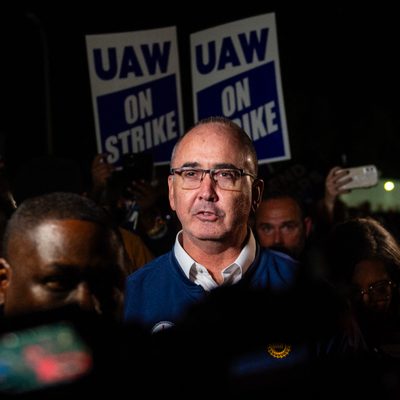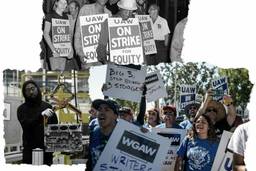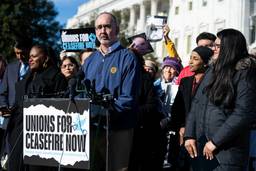Exclusive: UAW President Shawn Fain on How the Auto Workers Won and What’s Next
Fain talks with Steven Greenhouse about a unified working class, new organizing, battery plants, Biden and Trump.
Steven Greenhouse and Shawn Fain
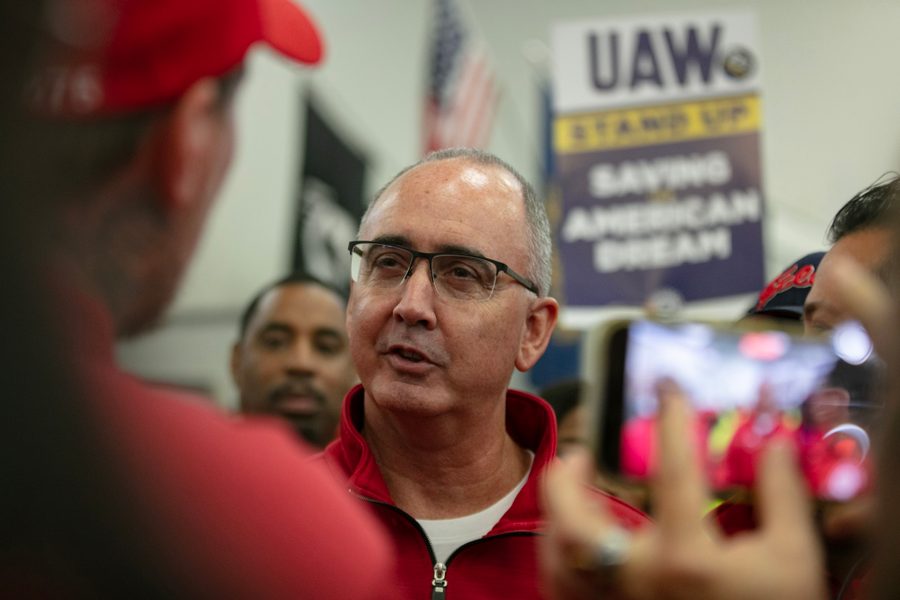
When Shawn Fain won the presidency of the United Auto Workers last March as an insurgent candidate, promising to transform the union and take on Detroit’s automakers, he spoke with veteran labor journalist and Century Foundation senior fellow Steven Greenhouse for In These Times. Fain laid out a militant agenda.
“We need to run contract campaigns where we engage the membership and go after their demands,” he said. “We haven’t done this in my lifetime.”
Six months later, Fain led targeted strikes against Ford, GM and Stellantis that have secured tentative agreements that include a 25% wage increase — more than all the raises that auto workers have received over the last 20 years combined. As UAW members began voting on the agreements, Greenhouse spoke with Fain again on November 5.
Steven Greenhouse: You’ve come a long way, as they say, since we last spoke. Congratulations on the tentative agreement the UAW won at Ford, General Motors and Stellantis. How did you and the union pull it off?
Shawn Fain: Basically, we exercised the power of the membership. When workers withhold their labor, nothing moves.
A lot of us have been within the system for years, so I thought it was important to bring in some new people to give us a fresh perspective on things. And we came up with a really good plan. This was our first-ever [simultaneous] contract campaign against the Big Three [automakers]. I think that was a very important piece. So was getting the membership rallied around our cause.
We had members and locals holding rallies to get energy behind the campaign and our issues and our stand-up strike strategy. And then there was the transparency with the membership, which was unprecedented in our union. Just the fact of being out there doing Facebook Lives with our members and doing messaging around our issues.
That didn’t just unify our members, it unified the public. Throughout this process, 75% of Americans were supporting our cause. I would have liked more time to plan for it. But with the short amount of time we did have, I think everyone involved just did a hell of a job.
SG: What do you think the contracts that the UAW won mean for the larger labor movement?
SF: To me, it’s a new day in the labor movement. These contracts are setting a new standard. I don’t think anyone should underestimate the power of the movement.
What organized labor has to offer is, we identify with working-class issues, union or not. I think our message resonates with working-class people everywhere.
There’s been a huge disconnect between the corporate class and the working class in this country. Most working-class people don’t have a union and are living paycheck to paycheck, working excessive hours, scraping to get by.
As I said over and over throughout the campaign, bargaining and organizing go hand in hand. I really believe, as we bargain good contracts, it’s going to lead to us organizing more workers and seeing a lot more success for working-class people, not just in America but all over this world.
SG: Can you talk about Toyota’s decision to raise its factory pay just days after the UAW announced its settlements?
SF: Obviously, Toyota isn’t doing this out of the kindness of their heart. They could have given this money a year ago, or six months ago. It’s not a coincidence that after we bargain these great contracts, all of a sudden they decided to reduce their progression to full pay from eight to four years and give [workers at the top rate] a 9% pay increase. We’re calling that the UAW bump.
We look at the workers there as future members. When they join the UAW, they’ll realize the full benefit of having a union — the full extent of the benefits we have and the wages we provide.
SG: You have said that you hope to use the victories at Ford, GM and Stellantis to help organize workers at Toyota, Tesla and elsewhere. Without asking you to tip your hand, can you tell us some about your strategy?
SF: Setting a standard leads to organizing workers. Throughout this whole bargaining process, with all of our messaging and Facebook Lives, we’ve had workers [from other companies] reaching out — hundreds and hundreds of workers daily — wanting to be a part of this. And now we’re seeing non-union companies giving raises. We’re affecting other areas just by bargaining a good contract for us, and those workers see that.
I found it interesting when Bill Ford stated that we need to focus on the real competition and take on the Toyotas and [other foreign automakers and Tesla]. As I’ve said before, Toyota and those companies may be Ford’s competition, but I believe the workers in those places deserve a good standard of living also. They deserve better. And I believe the UAW could bring that to them.
When the Big Three [were first] organized, people wanted to be a part of it — they saw a better way of life. I think people are seeing that now with what we’ve just done.
I’m not going to get in-depth on our strategy, but we have a plan. We’re working it out now. And we’re going to get busy bringing more people in.
SG: You have suggested that other unions seek to link up the expiration dates of their contracts so that they expire on the same date. Can you explain what that would do?
SF: If there was one good thing that came out of COVID, in my opinion — with all the loss of life and the bad things that went on — it was that working-class people realized that life shouldn’t revolve around working seven days a week, 12 or 16 hours a day, or working multiple jobs just to survive. There was not a better example than the fast food industry. Workers would [risk their lives to] go to fast food restaurants to work for $12 an hour. And people on social media were having a meltdown because they couldn’t get their French fries. It was a great example for working-class people everywhere that we have the power: When we withhold our labor, nothing moves.
If I could have a dream scenario, it would be that all of organized labor maps their expiration dates to May 1. May Day is a very significant day in labor history, going back to the Haymarket riots and the fight for the eight-hour workday.
When 26 billionaires have as much wealth as half of humanity, there’s a crisis. And the biggest way to stop that crisis is for working-class people to get unified. When we all stand together, the working class gets our fair share of equity and the fruits of our labor. It doesn’t matter if a corporate class builds 20 factories; if there aren’t workers to man it, they’re not going to make any product. We just have to get unified in this country and globally, and withhold that power if conditions aren’t how they should be for working class people everywhere.
SG: Can you explain what it means that the GM and Stellantis battery plants will be under the master contract? Will the workers be earning the same as the Big Three workers? Or will they be earning 75%? And where does Ford fit into all this?
SF: Getting this work under the Master Agreement was one of the key things we tried for. It’s a very delicate situation because these companies created these joint ventures [with foreign companies at what will initially be non-union plants]. Technically, we couldn’t make them bargain over it — it’s a “permissive” [non-mandatory] subject.
We got Stellantis and GM [battery] workers under the master agreement, and we got transfer rights for some of our members to go into those jobs as they ramp up. With an up-and-coming industry there’s concern about costs, so part of the tradeoff was that we did agree that anyone that’s hired off the street [rather than transferred] will start at 75% of the [master agreement] base rate. But each year, as we get guaranteed wage increases, that base rate goes up. By the end of the agreement, workers hired off the street will be at, ballpark, $31- $32 an hour. And because they’re under the master agreement, we can bargain for them in the next round of bargaining.
Ford is a different scenario. The battery plant in Marshall, Michigan, is a joint venture that Ford owns, and so that will be under the master agreement. The other two [Ford battery joint venture factories], we’re going to have to organize. We’re willing to do that. Ford didn’t want to come up to our standard of 75%, so we chose to fight that battle. As the [electric vehicle] plants ramp up, GM and Stellantis basically will have labor peace throughout that process. Ford chose not to have that.
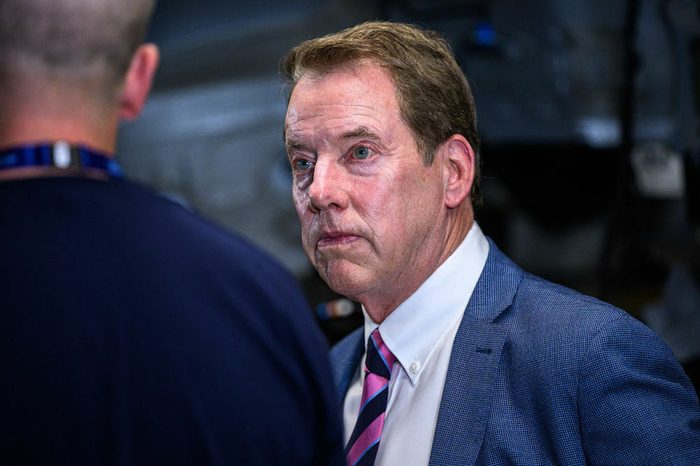
SG: For a while, it seemed that you and Bill Ford, the chairman of Ford, were really going at it with each other. Some people said that would make it really hard to reach a settlement, but the first settlement you announced was with Ford. How did that settlement come about?
SF: As far as things between me and Bill Ford or any of these other executives, I’ve got a membership I’ve got to represent and that’s what I’m going to do to the best of my ability. The executives have their issues they got to deal with, and at the end of the day those things worked out in our favor.
We had our marching orders from the membership, and our bargaining committee was tenacious in getting results. And we refused to be shaken by veiled threats.
When we began by taking the Michigan Assembly Plant out on strike, that was a big hit for Ford. That’s where they make the Bronco; that’s a very profitable plant. And when we took the Kentucky truck plant out, it was a huge hit — that’s their most profitable plant. And so they had to decide how much longer they wanted to endure losses rather than invest in their employees. I think that’s what it really came down to. “Okay, do we want to keep losing $50 million, $100 million a day, and [eventually] lose billions, or do we want to invest that money in our employees and get back to making products?”
SG: Some outsiders are voicing concern that the UAW won so much at Ford, GM and Stellantis that it will make them uncompetitive. What is your response to those skeptics?
SF: Every time I hear the word “competitive,” it’s just code for race to the bottom. All “competition” has meant in the past is that they want to find the lowest bidder, the cheapest competitor, to drive the scale down. It’s the same old: The corporate class wants to put fear out there and make workers afraid to ask for their fair share.
But what just happened? We bargained a great agreement, and the competition isn’t driving the scale down; Toyota is raising their standard for their employees because they know we’re gonna come after them.
The companies will try to take our record contracts and use the union as a scapegoat for raising prices. Well, nobody said a word the last four years when the price of vehicles went up 30% to 35% on average and our wages went backwards. Nobody said a word. All that fearmongering [has translated to] consumer price gouging in the name of corporate greed. They don’t have to raise prices a dime. With the contract they negotiated, they’re still going to make billions of dollars in profits.
SG: President Biden in many ways stuck his neck out in joining a UAW picket line. Is the UAW ready to endorse Biden for president, and if not, why not?
SF: I’ve said since I was elected that our endorsements are going to be earned. Right now, the membership is not focused on politics. Our focus is 100% on our membership getting the info they need for these tentative agreements, on answering any questions they have and letting the members decide. We’ll address the political issues at the appropriate time.
SG: Will walking the picket line at least give the president a leg up?
SF: I mean, for the first time in this country’s history, an American president showed up and joined workers on the picket line. That means a lot.
SG: And we did see a contrast between the leading candidates.
SF: Yeah, we saw one president visit a picket line and speak to striking workers, and we saw another one [Donald Trump] show up at a non-union plant that really had nothing to do with our members. So there’s a pretty big disparity between the two in that avenue. Right now, though, everything’s focused on our contracts, and not just Big Three — we still have Blue Cross Blue Shield workers on strike, Mack Trucks.
SG: A New York Times poll today shows Donald Trump leading Joe Biden in Michigan by 5 percentage points, 48% to 43%. What do you think about that?
SF: Honestly, I would say I’m disappointed. I don’t see that being the case as we get further into this election. I think Michiganders are smarter than that. Trump’s track record speaks for itself. He was president when GM was on strike in 2019, and I didn’t hear him say a thing about the UAW members. And go back to 2015, when he was running for president, he talked about doing a rotation of our jobs—taking them away from Michigan and the Midwest and sending them somewhere else in the country, the South, where they pay less money, and then having workers beg for their jobs back at lower wages.
And you go back to the economic recession in 2008-09, he was jumping on the bandwagon of blaming UAW members and our contracts for what was wrong with these auto companies, which was just a flat-out lie. A person’s factual track record, their own statements, speak volumes to me. I do believe we just have to put the facts in front of our members. We’ll do the appropriate discussion at the appropriate time. I think the right decision will be made, and we’ll see where things go.
SG: I wrote a book in which I devote a chapter to Walter Reuther, president of UAW from 1946 until his death in 1970, who I think was the greatest labor leader of the 20th century. What have you learned from Walter Reuther?
SF: He was a visionary leader. He was fighting a battle for national healthcare back in the ‘40s, ‘50s, ‘60s, and just for everything — better wages, pensions, retirement security.
The thing that I think he did best was he worked hard to unify the labor movement, not just in America, but globally. He was well respected among leaders, not just union leaders, but leaders all over the world.
Our union was very unified back in those days. Over the last 40 years, with complacent leadership and company unionism philosophies, we got away from that and the membership got left behind. I’ve been President for seven months, and I think the thing I’m most proud of right now is just the fact that when I stepped into that [UAW] bargaining convention on March 27, it was a lot of hard feelings, it was a divided house, and the one thing I’ve seen happen throughout this contract campaign was our membership come together like I’ve never seen it in my 29 years. When organized labor gets together, and when workers come together and put our petty differences aside, we can achieve great things. I think that’s one of the best lessons we can learn from his history and his leadership. And we’re going to continue to build on that.
This interview has been lightly edited for length and clarity.
Steven Greenhouse is a former New York Times labor reporter, a senior fellow at the Century Foundation and author of Beaten Down, Worked Up: The Past, Present and Future of American Labor.
Shawn Fain is the President of the United Automobile Workers.
